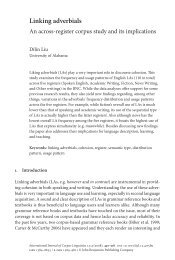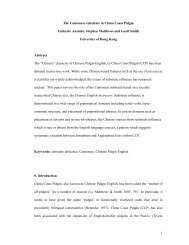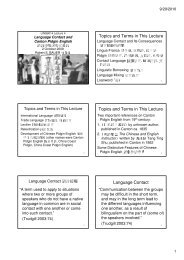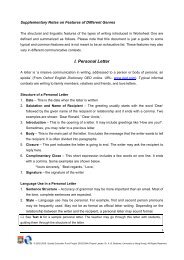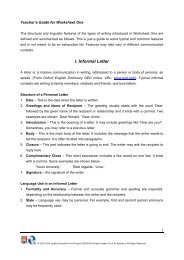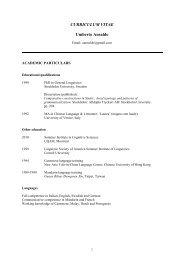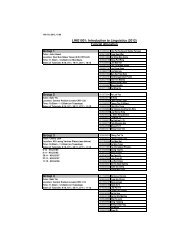The Bilingual Brain: Bilingual Aphasia
The Bilingual Brain: Bilingual Aphasia
The Bilingual Brain: Bilingual Aphasia
Create successful ePaper yourself
Turn your PDF publications into a flip-book with our unique Google optimized e-Paper software.
204 FRANCO FABBRO<br />
thought to be due to the ‘‘takeover’’ of linguistic functions by the contralateral hemisphere<br />
or by undamaged areas within the same hemisphere (Bychowsky, 1919/1983;<br />
Cappa, 1998). Improvement in communication skills may probably depend on the<br />
application of explicit compensatory strategies (Paradis, 1994; Paradis & Gopnik,<br />
1997). Recovery, either spontaneous or following rehabilitation, may continue also<br />
during the late phase, though generally less intensively than during the lesion phase.<br />
Patients should be periodically reassessed so as to reexamine recovery patterns and<br />
possibly revise the rehabilitation program. <strong>The</strong> most common patterns of recovery,<br />
described by Pitres (1895) in the first monograph on bilingual aphasia ever published,<br />
are (1) parallel recovery, when both languages are recovered simultaneously;<br />
(2) selective recovery, when only one language slowly comes back and the other is<br />
never recovered; and (3) successive recovery, when one language improves before<br />
the other(s).<br />
Language Recovery in Polyglot Aphasics<br />
When bilinguals or polyglots suffer a brain insult affecting language areas, they<br />
may lose the ability to use all languages they knew and exhibit the same type of<br />
aphasia in all languages. Subsequent recovery may be parallel in all languages. In a<br />
study on the literature of bilingual aphasia published in 1977, Paradis stated that 40%<br />
of the reported cases of polyglot aphasics exhibited parallel recovery of languages.<br />
It should be noted, however, that these statistics are based on clinical case histories<br />
which have been published and, thus, are the most atypical. Paradis put forward the<br />
hypothesis that this type of recovery is even more frequent because descriptions of<br />
single clinical cases of polyglot aphasics with parallel language recovery are very<br />
rare, since neurologists and neuropsychologists tend to describe ‘‘exceptional’’ cases<br />
only, as they can more easily be published (Paradis, 1977). This is one of the reasons<br />
why over 10 years ago Paradis started an international project on bilingual aphasia<br />
in Canada, which is still operative and sees the participation of numerous researchers<br />
from all over the world. This study also includes bilingual aphasic patients with any<br />
type of language disorders so as to have a large number of subjects and, thus, more<br />
reliable statistical data.<br />
In some cases, aphasia affects only one of the languages known by the patient. In<br />
his study of 1895, Pitres was the first to draw attention to the fact that the dissociation<br />
of the languages affected by aphasia was not an exceptional phenomenon, but rather<br />
ordinary. Pitres described seven clinical cases of patients exhibiting differential recovery<br />
of the two languages they spoke. On the basis of the frequency of dissociation,<br />
Pitres put forward hypotheses on the causes that might determine a better recovery<br />
in one language. He suggested that patients tended to recover the language that was<br />
most familiar to them prior to the insult. This hypothesis was subsequently called<br />
Pitres’ rule. In proposing his theory, Pitres referred to a work by Ribot in which it<br />
was claimed that, in the case of memory disorders, the general rule held that the new<br />
deteriorates earlier than the old. Subsequently, numerous neurologists compared and<br />
contrasted the so-called Pitres’ rule (recovery of the most familiar language) with<br />
‘‘Ribot’s law’’ (recovery of the native language), but it should be noted that none of<br />
the two authors ever formulated a ‘‘rule’’ on language recovery in bilingual aphasics.<br />
In his work, Pitres proposed a reasonable explanation of language recovery in<br />
aphasics. He maintained that the recovery pattern could occur only if the lesion had<br />
not destroyed language centers, but only temporarily inhibited them through pathological<br />
inertia. In Pitres’ opinion, the patient generally recovered the most familiar<br />
language because the neural elements subserving it were more firmly associated. If<br />
the patient had become aphasic owing to ‘‘functional inertia’’ of the language areas,



